Ask yourself, is it safe to burn that debris pile today? 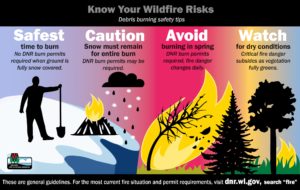
Warmer temperatures have caused several southern Wisconsin counties to jump to HIGH fire danger, while others are seeing rapid snow-melt or flooding near riverways. Don’t be surprised to see a lot of variation on Wisconsin’s landscape in the days to come. Spring is wildfire season and conditions can dry out quickly on warm and windy days, especially in areas of grass or light vegetation. It’s a good reminder that fire danger and burning restrictions can change daily. Be safe out there– check before you burn! https://dnr.wi.gov/topic/ForestFire/restrictions.html
Month: March 2019
Arbor Day: the trees that mark our lives
From the Bur oak that holds a child’s first tree house, to under the Kentucky coffee tree where adolescent friends shared secrets , to the willow a couple plants in the backyard that grows with their family. Trees can act as the pin points of our lives. Continue reading “Arbor Day: the trees that mark our lives”
Trees for Healing
Trees help your body heal. They boost your immune system, help you recover faster, and you’ll need fewer pain relievers. Continue reading “Trees for Healing”
The Urban Wood Toolkit available to communities
Are you looking to find the highest and best use for removed urban and community trees? The Urban Wood Toolkit is here to assist in developing a marketing and utilization strategy for communities to reduce costs and to connect communities with local forest products manufacturers to grow economic opportunities.
Continue reading “The Urban Wood Toolkit available to communities”
WAA/DNR Conference has another record year!
The 2019 WAA/DNR Annual Conference was held in Green Bay on February 17-19. This year surpassed last year’s record attendance and showcased a variety of wonderful presenters from across the country. Those in attendance were from the private industry, business owners, municipal staff, and state employees. The conference had five different tracks: general sessions, climbers corner, introductory, business and utility. Across these tracks many topics were covered, from insects and pests to climbing and ensuring morale amongst staff. This three-day conference also hosted many different exhibitors from the industry to provide up-to-date technology, equipment and practices to improve their work. Continue reading “WAA/DNR Conference has another record year!”
Applications for Forest Legacy Program due June 14
Landowners interested in participating in the Forest Legacy Program are invited to submit a completed application by June 14, 2019.
The Forest Legacy Program is a federal program that provides grants funds to states for the protection of environmentally important forest land from conversion to non-forest uses. Wisconsin’s implementation strategy focuses on keeping forests as forests by protecting large (> 1,000 acres) unfragmented blocks of forest land that provide the highest conservation value and public benefit through the purchase of conservation easements. Conservation easements convey a ‘purchased’ set of negotiated property rights, while allowing landowners to continue to own and manage their land, including the right to sell.
To request an application and more information about the Forest Legacy Program, contact Ron Gropp at ron.gropp@wisconsin.gov or 715-281-6253. Only lands within one of Wisconsin’s Forest Legacy Areas are eligible.
Don’t change EAB plans due to cold weather
By Bill McNee, forest health specialist, Oshkosh, bill.mcnee@wisconsin.gov, 920-360-0942
The recent frigid temperatures in late January and early February are likely to kill many overwintering emerald ash borer (EAB) larvae, but the tree-killing pest isn’t going away. The insulating properties of tree bark keep the larvae warmer than the outdoor air temperature, and wind chills do not affect the larvae because they are sheltered. The pest is also adapted to subzero temperatures based on its native range in eastern Asia where cold winters are common.
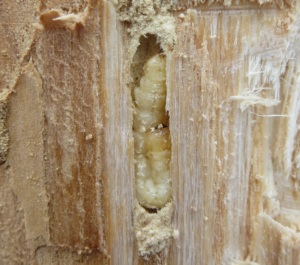
Overwintering prepupal larva, from February 2019 in Brookfield, WI.
On the morning of January 31, many parts of Wisconsin had low air temperatures between -30 and -35 degrees F. In places where it was this cold, scientific studies predict that most EAB larvae will be killed. Where low temperatures were between -20 and -30, larval mortality is likely to be lighter. Overwintering larvae were examined about 1 week after the cold snap in Brookfield (Waukesha County), where the low was -26, and few of the larvae were observed to have physical signs of freezing damage. Many of the larvae began moving within three days of being brought indoors. However, physical damage to the larvae may not yet be apparent, and normal-looking larvae may ultimately die from the cold temperatures.
Populations of the pest are likely to rebound, since each female beetle that emerges this summer will lay as many as 200 eggs. It is not currently known if larval mortality will significantly delay ash tree decline and mortality, although this may occur in areas that experienced the lowest temperatures. A cold spell in early 2014, that was not quite as cold, had no noticeable impacts on EAB spread or ash decline/mortality in areas known to be heavily infested.
The introduced biological controls of EAB, commonly known as “EAB wasps,” are at least as cold-tolerant as EAB. It is expected that these wasps will persist in and around release sites and continue parasitizing EAB eggs and larvae.
Forestry experts do not recommend changing EAB management plans solely due to the cold weather.
- Continue to look for EAB in ash trees. Woodpecker damage is a good sign that an ash tree is infested with EAB or other pests.
- Insecticide treatment of high-value ash trees near known infestations should be continued this spring.
- Don’t delay tree removals or timber harvests that are already scheduled. Giving non-ash tree species more time to grow means that the future impacts of EAB will be reduced.
- Continue planting non-ash tree species.
- To help slow the spread of EAB, review firewood rules in Wisconsin. Buy firewood in the local area where you plan to burn it or buy Wisconsin-certified firewood that has been treated to eliminate pests. Certified firewood is often available at DNR-managed properties or you can buy from an independent certified firewood dealer.
Additional information about emerald ash borer, insecticide treatments and forest management can be found online at www.emeraldashborer.wi.gov.
Ice, snow and deep frost: winter creates problems for trees
By forest health specialists Linda Williams, Woodruff, Linda.Williams@wisconsin.gov, 920-360-0665; Mike Hillstrom, Fitchburg, Michael.Hillstrom@wisconsin.gov, 608-513-7690; Alex Feltmeyer, Plover, Alexandra.Feltmeyer@wisconsin.gov, 715-340-3810
Heavy ice and snow loads can cause significant problems for trees. Branch tips and whole branches may break under heavy loads, and in windy conditions entire tree tops can come crashing down.
Freezing rain on February 4, 2019 covered trees around the state with a ¼” thick layer of ice. The weather then turned bitterly cold, leaving the ice stuck to the branches, weighing them down and straining the trees. Following that event, a snow storm affecting most of the state led to more ice, snow and damage to branches.
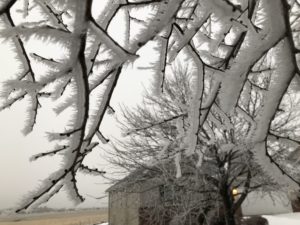
These extraordinary ice formations may look light and frosty, but they add a lot of weight to tree branches and can cause branch breakage.
Some trees are more susceptible to winter damage. Small trees can be particularly prone to injuries caused by heavy ice and snow. They can bend so far over from the weight that their tops are near or even touching the ground. In some cases, their stems may break at ground level causing the entire tree to fall over. Other vulnerable trees include those with ingrown bark at branch unions. This type of branch union is weak and more likely to split under heavy loads.
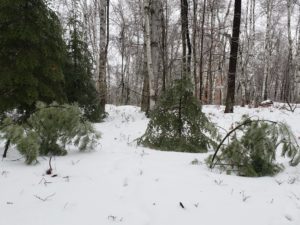
These young white pines were coated in ice, causing them to bend over. They may not rebound well after the ice and snow melt.
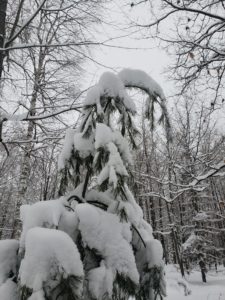
The heavy snow on the branches of this young white pine have caused the branches to droop and the top to bend over significantly. Heavy snow loads can cause branches to break.
While forest trees are just as prone to winter damage, yard trees present the most safety hazards and should be seen by an arborist as soon as damage becomes evident. Storm-damaged trees may have dangerous features such as hanging branches, branches under tension, spring poles and cracks in the main stem. Depending on the damage, some yard trees may also require pruning to correct their form and protect them from future injuries. Due to the dangers associated with storm-damaged trees, consider having a professional arborist or logger do your tree pruning or removal.
Tree roots can be damaged in cold weather too. In areas of southern Wisconsin, a lack of snow during some of this winter’s cold snaps has forced the frost deep into the ground. Some of you may recall the winter of 2002-2003 when we had very little snow and frost went 5’ deep in many parts of the state. Not only did it freeze septic systems and water lines that winter, but it also damaged tree root systems by killing some of the fine roots and root tips that grow deep below the surface and prefer not to freeze. Trees that lost a significant number of roots experienced crown dieback and stress that led to insects and diseases attacks, including two-lined chestnut borer on oak and Armillaria root rot on conifers. Deep freeze damage to tree roots is not often the single cause of tree stress or death but is more often one of several stress agents that leave trees more susceptible to insects and diseases. Fortunately, the deep frost can be pulled out of the ground, and some of the damages avoided, if there is enough snow cover for the remainder of the winter.
For more information on how snow and ice can impact trees, check out these resources from Wisconsin [PDF] and Minnesota. Contact a certified arborist or DNR forester if you want to discuss management options for storm-damaged trees.
